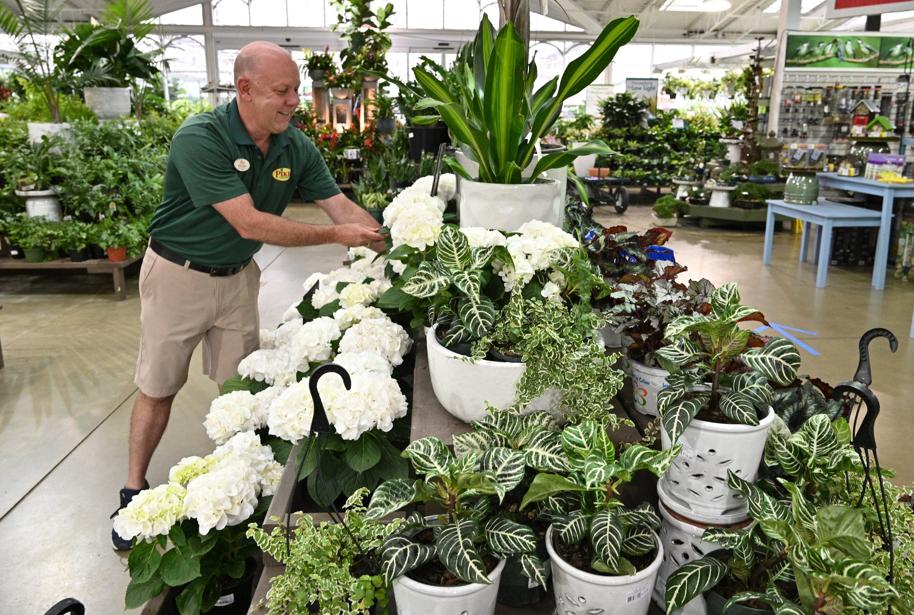
HOME AND GARDEN May 04, 2020By
- Mary Welch, For the AJC
Stuck inside? Design your own plant-filled sanctuary.
It’s fair to say hundreds of wannabe gardeners are flocking to hardware stores, nurseries and do-it-yourself warehouses to purchase flowers, shrubs and vegetables. Some will, in fact, discover a green thumb and subsequently be overwhelmed with squash and tomatoes, while others will curse the elements for their lack of success, blaming the weather, interfering animals or not enough space.
But there is a solution — indoor gardening. There are a variety of options to start your own greenhouse that will not only enhance your home decor but help purify your air.
“The key to an indoor garden is getting plants that are super easy and don’t require much care,” says Terry Furuta, owner of Terry Furuta Floral Designs in Buckhead. “There are some plants that can be tricky, like ferns. Some believe that orchids are difficult, but I love orchids, and if they’re in the right location, it’s easy.”

Lady slipper, an easy-care plant that Terry Furuta of Terry Furuta Floral Designs in Buckhead recommends. (Hyosub Shin / Hyosub.Shin@ajc.com)Photo: For the AJC
To have success with your indoor greenhouse, the first step is to determine the amount of light and select plants that thrive in that environment, says Michael Chapman, a horticulturist with Pike Nurseries.
Be mindful of where the windows are, what direction they face and how far from the window the plant will be placed. Holley Beagle, nursery manager at Grant Park’s Garden*Hood, says a good way to figure out the light situation is to set up a blank piece of paper in the spot where you are planning to place the plant and hold your hand about a foot off of the paper during the brightest part of the day. If there is a clear shadow, that indicates a bright light; a fuzzy shadow means medium light; and no shadow equals no light. Rotate the plant every couple of weeks so it grows evenly rather than toward the light.
The thicker and greener the leaves, the less light they require, says Evelyn Willis, a designer with Willis Flowers in College Park. She’s a fan of the snake plant (also known as the mother-in-law’s tongue), which can be neglected for weeks, can survive in low levels of light and has few insect problems.

Succulents at Pike Nurseries’ Lindbergh location on Thursday, April 30, 2020. (Hyosub Shin / Hyosub.Shin@ajc.com)Photo: For the AJC
The next step is important because it is the major reason why plants die — overwatering. Plant soil should be checked weekly; put your hand slightly on the top of the soil, if it’s moist, don’t water. However, if it’s dry, give it a good soak, and leave it alone. It’s preferable to fully saturate the soil and allow it to dry out in between waterings.
“There are telltale signs you’ve watered too much,” Chapman says. “If the leaves are starting to wilt, cut back.” There are moisture meters that indicate the soil’s moisture level, and he advises only using self-watering plant orbs for vacations, not everyday use.
Another consideration is the container. Not only must it have good drainage (or rocks at the bottom), but it must be appropriate for the plant. “How much space do you have to utilize?” asks Beagle. “The plant will grow into the container. Don’t start with a large pot. Don’t go more than twice the size of the pot that it’s currently is in. A frequent mistake is that people put a smaller plant into a large container, and they run the risk of overwatering.”
Chapman recommends not repotting the plant until at least six months to eliminate stress. He agrees that upping the container size should be gradual. “If you go from a six-inch pot to a 12-inch, you will not be successful. It needs to get acclimated to the situation and humidity before transplanting.”
Regardless if the plants are needy or easy, all need fertilizing and may have an insect issue. Insects, partially little white bugs that look like cotton on the back of the plants, can be easily eliminated with organic sprays, neem oil or insecticidal soap.
As for fertilizing, Beagle recommends monthly feedings while Chapman prefers only a couple times a year, especially in the spring.
Another way to have an indoor greenhouse is one of Furuta’s specialty: a terrarium. He even gives classes on building a terrarium. “Terrariums require no maintenance, and they’re perfect for people who have other homes or travel a lot. You can leave them for months at a time, and they’ll take care of themselves. And, they’re fun to watch. They have their own ecosystems, and it rains inside because of the condensation.”

Cloche Terrarium designed by Terry Furuta, owner and florist, at Terry Furuta Floral Designs in Buckhead on Saturday, May 2, 2020. (Hyosub Shin / Hyosub.Shin@ajc.com)Photo: For the AJC
So, which plants are the easiest, and which are for the more experienced gardener? There seems to be a split on orchids. Futura says they’re easy, while Willis and Monica Losick, a floral designer with the Flower Cottage on Main in East Point, consider them temperamental. “You either have luck with them or you don’t,” says Losick simply.
Not all people are fans of ferns, either, although they do tend to thrive in the bathroom. If you stress out a ficus tree, it will quickly drop its leaves. Losick says that succulents don’t require much water and flourish in small, compact indoor gardens. “They’re a little minimalistic and easy.”
All said that indoor plants are easy as long as you look for signs of overwatering or improper sunlight. “You’ll build a relationship over time with your plants,” says Chapman. “And, then all you have to do is look at it, and you’ll know what it needs.”
(Continued)
You must be logged in to post a comment.